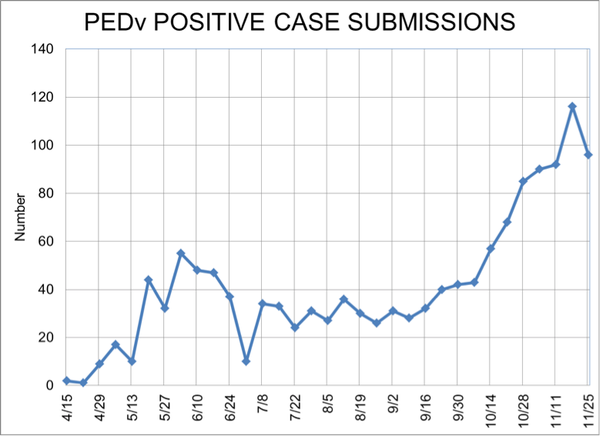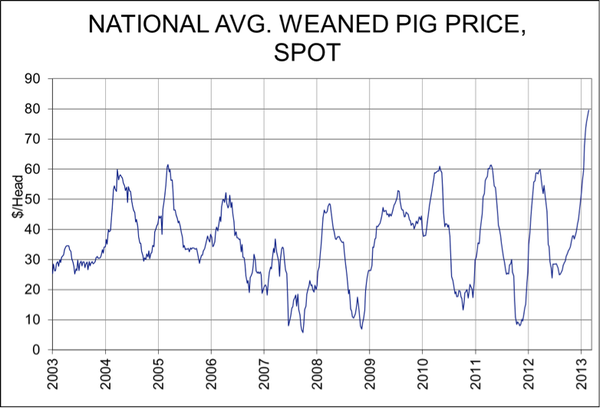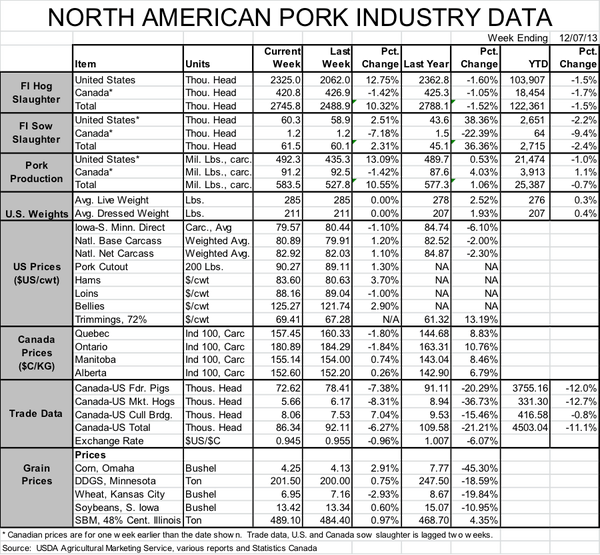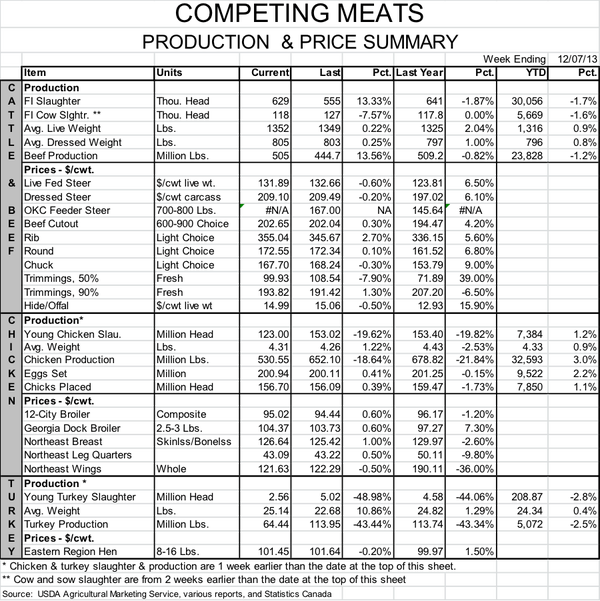Are We Frittering Away Profit Possibilities to Keep Facilities Filled?
December 9, 2013

Porcine epidemic diarrhea virus (PEDv) is dominating the discussion in pork production circles these days and it is easy to understand why. While the number of new positive samples tested at disease diagnostic labs declined slightly in the week of November 24 (the last for which data are available), the weekly number was still the second highest on record (see Figure 1) and pre-dates the news that Nebraska has now recorded its first PEDv case. The disease is spreading steadily in Iowa and southern Minnesota and the break in Nebraska suggests that that previously unscathed state will likely see the kind of spread witnessed in other areas since May.

Demand for weaned pigs would have been high this fall even without PEDv. Lower costs would allow producers with free finishing space to pay more for pigs while still looking at what are expected to be good 2014 prices. So high-priced pigs were in the cards regardless.
But this high (See Figure 2)? Spot-market weaned pigs sold last week for an average of $79.56, another record-high in a string of record-highs that date back to mid-November, when the December 2005 record of $61.57/head was first broken. Clearly, this run-up is more than just lower costs as producers with slack space chase the available – and likely PEDv-tightened – number of weaned pigs.

Are we behaving like a bunch of cattle feeders, frittering away all possibility of profit to keep facilities filled? I don’t think so. My production costs model based on Iowa State University’s (ISU) historic costs and returns series says that, at current corn and soybean meal prices, May market hogs should cost about $156 to produce. That would put the breakeven price of a 200-lb. carcass at $78. Deducting an estimated weaned pig cost of about $42 means that the pig can be taken to market weight for $114. Add that to an $80-weaned pig and you get $194 or about $97/cwt. carcass. May futures are trading at $98.83 on Monday morning.
Those computations don’t leave much profit but they don’t involve red ink either. And the question is whether May – and following months’ – futures have incorporated these pig losses. My contacts suggest that those losses could be pushing 4 million head spread over the past 28-30 weeks. But Figure 1 suggests that the lion’s share of those losses have occurred in the past 10-12 weeks, a period that corresponds to marketings beginning in April. Lean Hogs futures prices currently suggest summer cash prices roughly the same as in 2012. Will supplies be large enough to keep prices the same as one year ago? It appears to me that the only way that might happen is for the sow herd and litter sizes to be growing very rapidly. We’ll get a read on those numbers in three weeks. Let’s hope the read is better than the one we got in September.
USDA report insight
Which brings me to this week’s rant. One thing is for certain: The December Hogs and Pig Report will be no better than producers’ responses to USDA’s survey which is ongoing. When quizzed about the obvious deficiencies in the September report, USDA statisticians repeatedly stated, “We continue to encounter problems with the response rate to the hogs and pigs survey.” That might be passing the buck, but the only way to keep it from being so is for everyone to respond with accurate numbers. And that especially includes you big guys, anyone who is experiencing PEDv losses and, for sure, any of you who fall in both groups! USDA uses historic data to estimate the numbers of large producers who do not respond. If a large producer is losing pigs, using historic data – the only thing USDA has! – will not yield accurate estimates. Therein probably lies the problems with the September report. Let’s not let it happen again.
To dispel the idea that all I do is rant, however, I want to de-rant (probably not a proper word but you get the gist) a bit regarding last week’s topic. Within a week of having one of the worst pork loins in memory, I had perhaps the best one I’ve ever eaten. It was prepared by Chef Mark Salter, proprietor of the Robert Morris Inn in Oxford, MD, at last week’s Pork Action Group meeting in Florida. It was a superb roasted rack of pork from a Berkshire program. Juicy, flavorful and almost unbelievably tender. Now Mark Salter knows exactly what he is doing but this product allowed his skills to be expressed in full!
Can every pork loin be this good? Probably not, because Mark Salter will not be cooking them all. But we need a lot of them to be more like the one I ate last week if we are to keep the consumers we have and win more to our products.


About the Author(s)
You May Also Like




